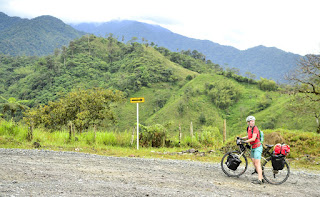We are now back in the UK, reflecting on our trip and pondering what we learnt from our adventure.
Whilst peddling and feeling philosophical, we came up with four guidelines for life that we tried to live by and reckon are worth hanging on to:
1. If the sun is up, you should be too; and preferably outside
2. Mornings for endeavour, afternoons for snoozing
3. If there is an outdoor body of water, swim in it
4. Ideas that feel a bit scary are probably worth exploring
We've also produced a final video, which is a bit thematic. You can watch it by clicking here.
In a rather shorter video, Ali undertook a project in vanity and beard growth during the trip - with a little help from a friend (kudos to Greg), below is a timelapse of said growth:
And last, but not least, last year we followed the progress of a team of scientists, engineers and adventurers who made their way by dugout canoe Into the Okavango. We were so inspired by their magical photos from the delta as they documented the wildlife.
Last year, Ali woke one Sunday morning to the sound of birds performing rituals, and splashing in and out of water. Perhaps a little dazed and even somewhat hungover from the wedding we'd been at the night before, it took him longer than you'd expect to wonder what this fantastic bird life was doing outside the window of our B&B in Grimsby! Of course it wasn't, Lizzie was listening to a field recording from the expedition.
We were so taken with the ability to close our eyes and transport ourselves to the banks of the delta, that we want to try something similar for you. Our recordings are not particularly high quality, but hopefully these little snippets will allow you to experience for a moment the wonderful bombardment of another of our senses whilst away:
Listening to the morning birds from the comfort of our tent on the banks of Lake Nicaragua in Ometepe, Nicaragua
And more of the same in Semuc Champey, Guatemala
Crickets and cicadas by the road as we pedaled through huge Jurassic Park-esque forests in Costa Rica
Camping next to a church in Guatemala where no-one except the priest spoke Spanish - however, the resident church band decided to start practicing as we tried to go to sleep and they DEFINITELY knew the word "Alleluia". This is recorded from within our tent.
Encountering howler monkeys for the first time whilst camping up at Tikal, an eerie Mayan ruin in Guatemala
The typical morning chorus we had on most days as we pedalled along
Sounds of the jungle at night in Costa Rica
And last, but not least, this bird which sounds like a bomb in a Bruce Willis film about to detonate
Thanks for reading. Cheerio.
Whilst peddling and feeling philosophical, we came up with four guidelines for life that we tried to live by and reckon are worth hanging on to:
1. If the sun is up, you should be too; and preferably outside
2. Mornings for endeavour, afternoons for snoozing
3. If there is an outdoor body of water, swim in it
4. Ideas that feel a bit scary are probably worth exploring
We've also produced a final video, which is a bit thematic. You can watch it by clicking here.
In a rather shorter video, Ali undertook a project in vanity and beard growth during the trip - with a little help from a friend (kudos to Greg), below is a timelapse of said growth:
And last, but not least, last year we followed the progress of a team of scientists, engineers and adventurers who made their way by dugout canoe Into the Okavango. We were so inspired by their magical photos from the delta as they documented the wildlife.
Last year, Ali woke one Sunday morning to the sound of birds performing rituals, and splashing in and out of water. Perhaps a little dazed and even somewhat hungover from the wedding we'd been at the night before, it took him longer than you'd expect to wonder what this fantastic bird life was doing outside the window of our B&B in Grimsby! Of course it wasn't, Lizzie was listening to a field recording from the expedition.
We were so taken with the ability to close our eyes and transport ourselves to the banks of the delta, that we want to try something similar for you. Our recordings are not particularly high quality, but hopefully these little snippets will allow you to experience for a moment the wonderful bombardment of another of our senses whilst away:
Listening to the morning birds from the comfort of our tent on the banks of Lake Nicaragua in Ometepe, Nicaragua
And more of the same in Semuc Champey, Guatemala
Crickets and cicadas by the road as we pedaled through huge Jurassic Park-esque forests in Costa Rica
Camping next to a church in Guatemala where no-one except the priest spoke Spanish - however, the resident church band decided to start practicing as we tried to go to sleep and they DEFINITELY knew the word "Alleluia". This is recorded from within our tent.
Encountering howler monkeys for the first time whilst camping up at Tikal, an eerie Mayan ruin in Guatemala
The typical morning chorus we had on most days as we pedalled along
Sounds of the jungle at night in Costa Rica
And last, but not least, this bird which sounds like a bomb in a Bruce Willis film about to detonate
Thanks for reading. Cheerio.










































